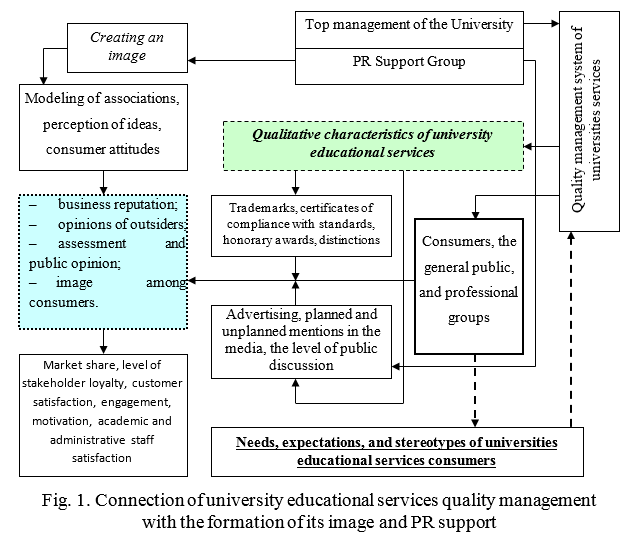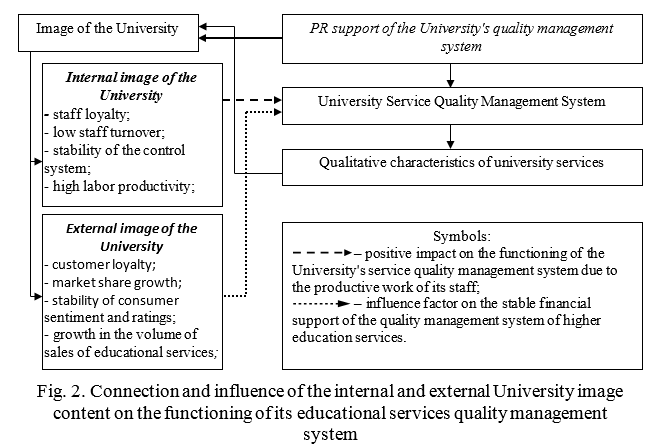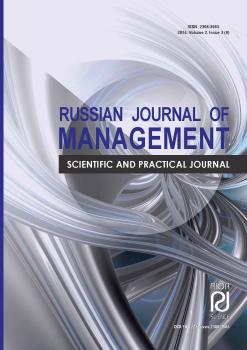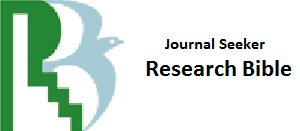Ryazan', Orel, Russian Federation
Groznyy, Grozny, Russian Federation
VAK Russia 08.00.05
VAK Russia 08.00.10
VAK Russia 08.00.12
VAK Russia 08.00.13
VAK Russia 08.00.14
UDC 33
UDC 37
CSCSTI 06.00
Russian Classification of Professions by Education 38.00.00
Russian Library and Bibliographic Classification 6
BISAC SOC SOCIAL SCIENCE
Results of the research determine that the University's image is implemented in an attempt to identify the needs and expectations of consumers, as well as to achieve a high level of compliance with these needs and expectations. The University's image creates a qualitatively new type of competitive advantage, forms an appropriate business reputation, a certain representation of the organization, which is achieved through PR support of the quality management system. Structurally, the process of forming the University's image is based on the established connection of managing the quality of educational services with the formation of the image and PR support, as well as the connection and influence of the content of the internal and external image of the University on the functioning of its system of managing the quality of educational services. The use of image formation tools and PR support of educational services quality management systems involves the consistent formulation of the current internal and external vision of the university, its correction in accordance with the provisions of the desired image vision model, the development and justification of the university image concept, the formation of a systematic image model, planning and implementation of the established image model of the university.
image, university, development, quality management, educational services
The growth of competition in the Russian market of higher education services is caused by a reduction of its consumer base and a significant number of educational organizations that operate on it, their branching network in the regions and other factors. All these circumstances determine the need to ensure sustainable competitive advantages of higher education institutions in their basic market of educational and R&D services. In the conditions of organizing the admission of applicants to universities on a budget form of education on the basis of a unified state exam, a certain competition among universities take place. Institutions rival for the most talented applicants, who, in the future, make up the intellectual potential of educational organizations and are evidence of the high quality education in these institutions.
In modern conditions, the most important competitive advantage of universities in the market of higher education services is their quality, which integrates a wide range of components that form high quality characteristics and consumer properties of educational programs. The solution of the issue of improving the quality of higher education services is largely conditioned by the implementation of specific management based on the methodology of quality management, specific standards, models and systems.
In this case, an important role is played by the process of forming the image of the university and PR support for the development of the services quality management system. The image of an educational organization is focused on key groups of stakeholders, the main role among which play consumers of educational services. It is implemented in an attempt to identify the needs and expectations of consumers, as well as to achieve a high level of compliance with these needs and expectations. At the same time, the main criterion for the effectiveness and efficiency of the university's image is the level of awareness by consumers of educational organizations information messages and their influence on the acceptance of a positive choice by an applicant. The image of the university creates a qualitatively new type of competitive advantage, forms the corresponding business reputation of the institution, a certain idea about it, which is achieved through PR support of the quality management system.
The theoretical and methodological basis of the research is presented by fundamental provisions of educational systems management theory, as well as the scientific achievements of scientists in the field of education economics, the theory of quality management and competitiveness of socio-economic systems functioning. In particular, the provisions of the concept of the positive impact of higher education system development on social development and the concept of the knowledge economy as a methodological basis for the study of the effectiveness of higher education system functioning and the qualitative characteristics of its services; the concept of human capital and educational potential in terms of the formation of higher education prerequisites for increasing labor productivity; the concept of the market of higher education services and its marketing management, according to which modern universities are subjects of competition, the development of which requires the formation of specific advantages in order to increase the market share of educational services and the formation of economic resources for further development; the concept of total quality management in terms of substantiating the objective need to develop quality management systems of universities based on a process approach with appropriate documentation.
In the course of the study, a set of theoretical and empirical research methods was used, in particular methods of analysis, induction, idealization and abstraction, formalization, modeling, graphical method and systematic approach.
Thus, the image determines the attitude and behavior of citizens towards the penitentiary system and, accordingly, its employees. Creating a positive image of Higher education institutions under the jurisdiction of the FPS of Russia through the media is an essential condition for the effective functioning and development of this social institution. The problem of organization's image forming and its impact on the quality and intensity of interaction with consumers of goods and services, as well as organization’s contact audiences, was developed in the works of scientists in the early 1990s. First of all, are worth to be toted the works aimed at studying the impact of the organization's image on the level of customer satisfaction and product quality [1; 2] and Vice versa, the impact of the quality characteristics of the product (service) on the organization's image [9].
Already during this period, the methodological foundations for assessing the organization's image and its impact on consumer satisfaction of goods (services) produced by the organization were significantly developed [6]. Modern concepts of forming and developing an organization's image involve special activities aimed at forming a specific vision of the organization among its consumers [5], as well as evaluating the impact of the formed image on the processes of attracting consumers [3]. It should also be noted the central role of image science in completely new management concepts, such as behavioral marketing [7], management of organizational culture [4], management of organizational image [8].
If we turn to the theory of management, enterprise economics and asset valuation, goodwill is a material manifestation of the image and business reputation of an enterprise, institution, organization. This indicator is a cost estimation of the asset price excess compared to the balance value that a potential buyer is willing to pay for it. In other words, the image is an intangible asset that is inalienable and consists in the fact that due to certain organizational, intellectual or other capabilities, other things being equal, the organization receives a large profit compared to competitors.
Thus, drawing a parallel with universities and the sphere of higher education, a high business reputation and a positive image is not the result of the best logistical, personnel, and other types of support formation, but is the level of organization quality and the use of such factors, assets and resources.
The development, implementation and continuous improvement of quality management systems for higher education services is not a capital-intensive process, but is achieved mainly by organizational measures. Thus, image management is an externally oriented component of the higher education services quality management system functioning, which requires a certain PR support. Summarizing the above, was carried out graphically by an appropriate interpretation of university educational services quality management association with the formation of its image and PR-support of its activities (Fig. 1).
The image of the University is an integral feature that characterizes a positive outlook contact with audiences, business reputation, the opinion of consumers, which are formed regarding the quality of performance by the University of its obligations under the provision of educational services and the performance of its fundamental roles in society.
The image of the university requires a certain basis, which is the qualitative characteristics of its educational services (formed as a result of the functioning of the quality management system), while the quality management system depends on the tools of image formation and PR support.
The formation and development of the university's image is aimed at correcting the behavior of various representatives of social, demographic and professional contact audiences in the direction of forming a positive perception of their initiatives, results, features and characteristics of educational services. It is possible to achieve this through the use of specific tools, forms, methods, measures of socio-psychological, emotional, managerial and economic influence on groups of stakeholders within the university and in relation to contact audiences outside it.

It should also be noted the importance of the image of the university for its internal environment, in particular the administrative and academic staff. In order to substantiate the nature of the image influence on the functioning of the university quality management system internal environment, a schematic model of the connection and influence of the internal and external university image content on the functioning of its educational services quality management system was constructed (Fig. 2).

If the external influence of the image is aimed at forming a certain representation of stakeholders in order to achieve loyalty and positive consumer choice, then the internal influence plays an important role in the functioning of the quality management system of the university, the more important conditions of which are the involvement of staff, their dedication to the institution, attempts to create additional consumer value of services at all stages of its passage within the process management system. Achieving this largely depends on the staff's sense of complicity, loyalty and inner conviction that the results of the work are really influential factors in the commercial success of the university and ensuring the economic, social, humanitarian, innovative development of the region and the national economy as a whole. The development of a positive image of the university confirms the effectiveness of the leadership position of the management, strengthens confidence in the decisions taken, which significantly affects the functioning of the university's quality management system and its overall management.
1. Andreassen, T. W., Lindestad, B. (). Customer loyalty and complex services: the impact of corporate image on quality, customer satisfaction and loyalty for customers with varying degrees of service expertise // International Journal of Service Industry Management. 1998. 9(1). P. 7-23.
2. Dobni, D., Zinkhan, G. M. In search of as brand image: a foundation analysis // Advances in Consumer Research. 1990. 17. P. 110-119.
3. Gouji, R. K., Taghvaei, R., Soleimani, H.. The effect of corporate image on the formation of customer attraction // Management Science Letters. 2016. 6. P. 655-670.
4. Kehinde, O. A. Organizational Culture and Its Corporate Image: A Model Juxtaposition // Business and Management Research. 2012 1(1), 121-132. https://doi.org/10.5430/bmr.v1n1p121
5. Latif, W. B., Islam, M. A., Noor, I. M., Mohamad, M., Kongsompong, K. Imagination of brand image for tourism industry // Problems and Perspectives in Management. 2016. 14(2-1). P. 138-142. https://doi.org/10.21511/ppm.14(2-1).2016.02
6. Mano, H., Oliver, R. L. Assessing the dimensionality and structure of the consumption experience: evaluation, feeling and satisfaction // Journal of Consumer Research. 1993. 20. P. 451-466.
7. Polinkevych, O., Kamiński, R. Corporate image in behavioral marketing of business entities // Innovative Marketing. 2018. 14(1). P. 33-40. https://doi.org/10.21511/im.14(1).2018.04
8. Schuler, M. Management of the organizational image: A method for organizational image configuration // Corporate Reputation Review. 2004. 7(1). P. 37-53.
9. Selnes, F. An examination of the effect of product performance on brand reputation, satisfaction and loyalty // European Journal of Marketing. 1993. 27. P. 19-35.















